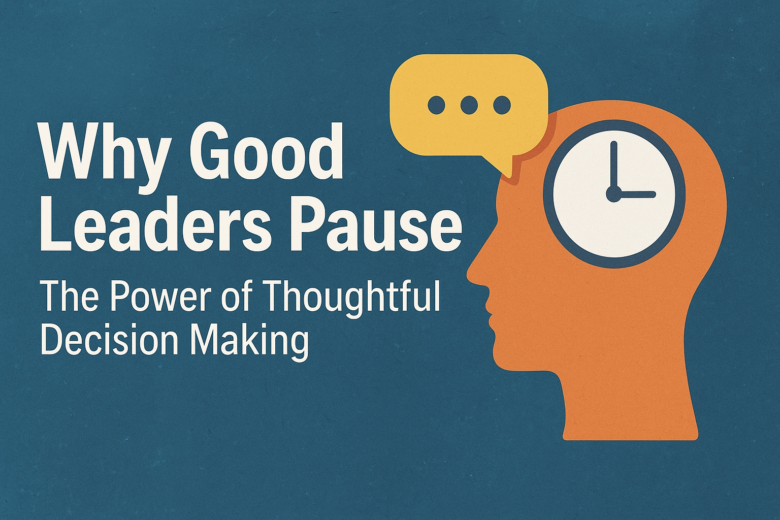After three decades in leadership, I’ve come to rely on one habit more than any other: the pause.
I wasn’t always this way. Early in my journey, I had a need to respond immediately and admired leaders who moved fast, answered instantly, and seemed to operate on pure adrenaline. Speed looked like strength. Decisiveness looked attractive.
But over time, I learned that good decisions don’t come from reacting first, they come from thinking well. Pausing has helped me separate noise from clarity, urgency from importance, and impulse from intention. It’s the small space that often makes the biggest difference. Now, I think before I act… even when I’m angry. Especially when I’m angry.
And as I’ve watched leaders, over the years, across different environments, some patterns have stood out.
The Two Tempos of Leadership
Most leadership behaviour falls into two broad patterns.
The first are the “fire first, aim later” leaders, driven by instinct, urgency, and momentum. They trust their gut, move fast, and believe that speed itself creates success. This style shines when the moment truly demands action, during a crisis, a fleeting opportunity, or a market that’s shifting by the hour. They believe patience is for the weak and it slows progress.
But when every situation is treated like a burning platform, something gives way. Teams burn out. Mistakes multiply, decisions begin to outpace wisdom. Negative energy spreads, Fear takes over.
Then there are the “pause-before” leaders. They create space between stimulus and response. They slow down, not to hesitate, but to observe. They think through consequences, seek context, and align action with purpose before they move. I clearly belong to this camp now.
Interestingly, personality plays a quiet but powerful role in which mode a leader tends to favor. Extroverted leaders, fuelled by energy and immediacy, often lean toward quick action. Meanwhile, more agreeable, conscientious or emotionally stable individuals naturally prefer to pause, reflect, and process before deciding.
Neither style is flawless. Overthinking can cost momentum, just as over-speeding can cost clarity. The real art of leadership lies not in choosing one over the other, but in knowing when to switch gears.
The Leadership Power of a Pause
In a world that rewards speed, pausing often feels countercultural. Yet some of the best outcomes I’ve witnessed in teams, businesses, and life came from leaders who waited just long enough to make a wiser decision.
I remember a moment in my leadership journey when I almost fired a senior leader based on a rumour that the person had compromised sensitive company information. My instinct was immediate action, anger and urgency pushing me forward. Instead, I paused. I bit my tongue, evaluated the situation thoroughly, and spoke with all concerned parties including speaking to the concerned leader. By taking the time to reflect and gather context, the situation was defused, a key talent was saved and a hasty decision was avoided. Another leader, reacting too quickly, might not have had the same outcome. That experience reinforced for me just how powerful a well-timed pause can be.
Pausing provides a powerful edge:
- Emotional control: You act with awareness, not anger or ego.
- Deeper connection: You listen before you lead, and your team feels heard.
- Broader perspective: You see the whole board, not just the next move.
- Better judgment: You separate what’s urgent from what truly matters.
At its core, pausing isn’t about delay, it’s about depth. It’s the ability to step back so you can see forward.
For me, patience has always been a strength. I take time before deciding, especially when something feels off or I’m being nudged toward a path that doesn’t align with my thinking. In leadership, that pause isn’t hesitation, it’s wisdom in action
Building the Habit of Pausing
The good news: pausing can be learned. Start small:
- Breathe first. Before responding in conflict, take a deep breath.
- Sleep on it. Give big decisions a night to settle, often clarity comes in the morning. If no answer arises, it may not be that important.
- Ask before you answer. One more question can reveal perspective before you give your opinion.
- Build reflection into your rhythm. Set checkpoints where your team can consider direction, not just execution.
These micro-pauses, when practiced consistently, build a muscle of awareness. Over time, they shape how you lead calmly, deliberately, and with intention.
I’ve lost count of the times a pause has saved me, sometimes from sending an email in anger, saying yes to a partnership that didn’t feel right, or chasing an idea before it was fully formed.
Pause, But Don’t Paralyze
Of course, pausing isn’t without its risks. Reflection can slip into overthinking, and overthinking can turn into paralysis. Some leaders mistake “pause” for “procrastinate,” and I’ve seen it happen more than once.
Every decision has its own rhythm. Crises demand immediacy. Operational choices benefit from a brief moment of reflection. Strategic moves call for a deliberate, thoughtful pause. And people decisions, the most delicate of all, require emotional clarity more than data. The real leadership skill lies in sensing that rhythm: knowing when to step in and when to step back. A pause is useful only when it helps you act at the right time, not simply later.
I don’t always pause. Decisions that require immediacy still get priority and action. The key is not to pause forever, it’s to pause just long enough to ensure your next step is deliberate.
The challenge, however, is always knowing the difference between thoughtful reflection and overthinking. Pausing works when it brings clarity; it backfires when it turns into rumination and hesitation. I’ve made my mistakes too.
The Power of the Pause
In a world obsessed with speed, slowing down is a radical act. Leadership isn’t a sprint, it’s a series of choices that shape teams, organizations, and lives.
The next time pressure mounts and decisions loom, pause. Breathe. Reflect.
Because often, the strongest, most enduring move a leader can make is the one that comes after some thought, not in the heat of the moment, but in the clarity of a well-timed pause.



